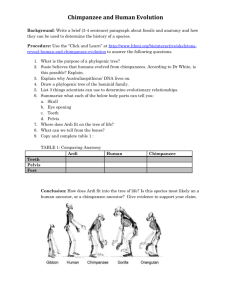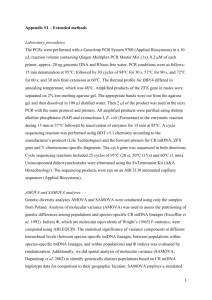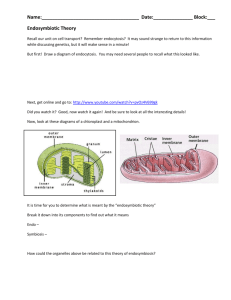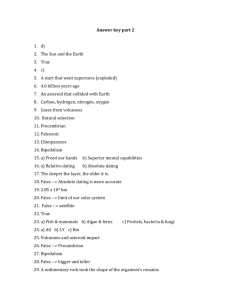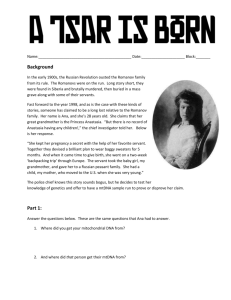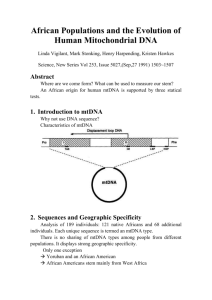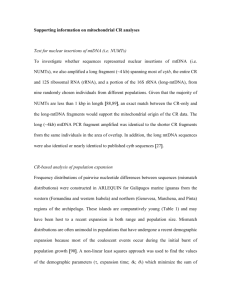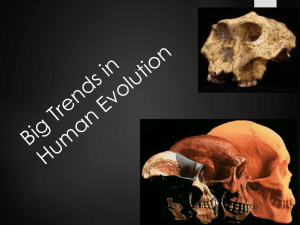72KB - NZQA
advertisement
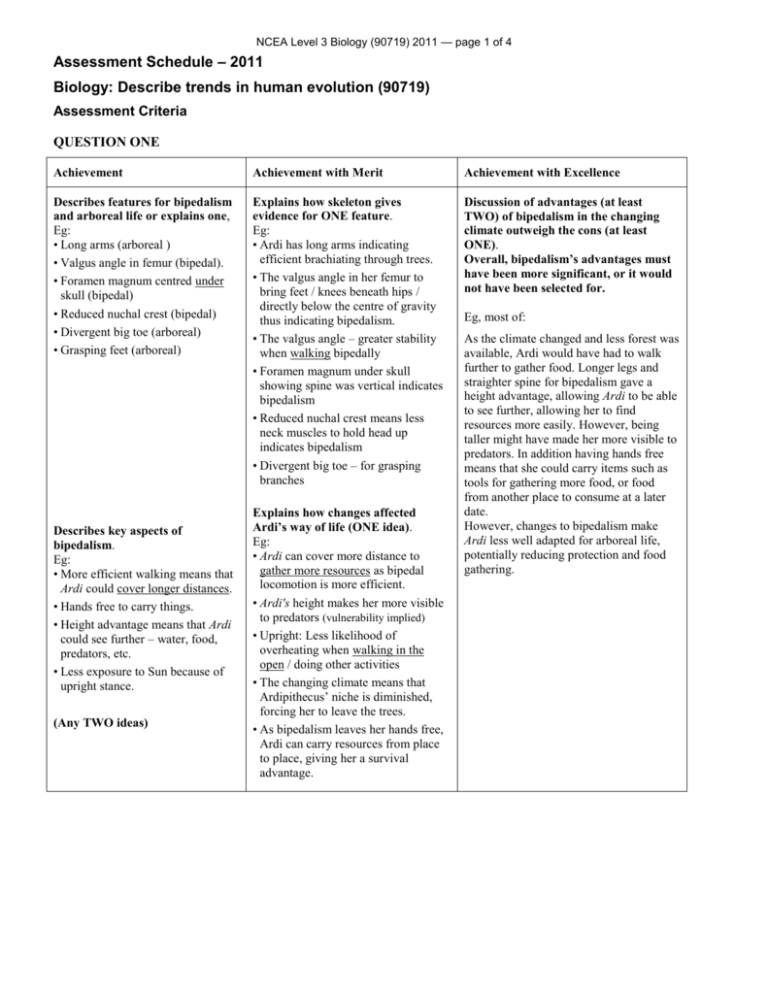
NCEA Level 3 Biology (90719) 2011 — page 1 of 4
Assessment Schedule – 2011
Biology: Describe trends in human evolution (90719)
Assessment Criteria
QUESTION ONE
Achievement
Achievement with Merit
Achievement with Excellence
Describes features for bipedalism
and arboreal life or explains one,
Eg:
• Long arms (arboreal )
• Valgus angle in femur (bipedal).
• Foramen magnum centred under
skull (bipedal)
• Reduced nuchal crest (bipedal)
• Divergent big toe (arboreal)
• Grasping feet (arboreal)
Explains how skeleton gives
evidence for ONE feature.
Eg:
• Ardi has long arms indicating
efficient brachiating through trees.
• The valgus angle in her femur to
bring feet / knees beneath hips /
directly below the centre of gravity
thus indicating bipedalism.
• The valgus angle – greater stability
when walking bipedally
• Foramen magnum under skull
showing spine was vertical indicates
bipedalism
• Reduced nuchal crest means less
neck muscles to hold head up
indicates bipedalism
• Divergent big toe – for grasping
branches
Discussion of advantages (at least
TWO) of bipedalism in the changing
climate outweigh the cons (at least
ONE).
Overall, bipedalism’s advantages must
have been more significant, or it would
not have been selected for.
Describes key aspects of
bipedalism.
Eg:
• More efficient walking means that
Ardi could cover longer distances.
• Hands free to carry things.
• Height advantage means that Ardi
could see further – water, food,
predators, etc.
• Less exposure to Sun because of
upright stance.
(Any TWO ideas)
Explains how changes affected
Ardi’s way of life (ONE idea).
Eg:
• Ardi can cover more distance to
gather more resources as bipedal
locomotion is more efficient.
• Ardi's height makes her more visible
to predators (vulnerability implied)
• Upright: Less likelihood of
overheating when walking in the
open / doing other activities
• The changing climate means that
Ardipithecus’ niche is diminished,
forcing her to leave the trees.
• As bipedalism leaves her hands free,
Ardi can carry resources from place
to place, giving her a survival
advantage.
Eg, most of:
As the climate changed and less forest was
available, Ardi would have had to walk
further to gather food. Longer legs and
straighter spine for bipedalism gave a
height advantage, allowing Ardi to be able
to see further, allowing her to find
resources more easily. However, being
taller might have made her more visible to
predators. In addition having hands free
means that she could carry items such as
tools for gathering more food, or food
from another place to consume at a later
date.
However, changes to bipedalism make
Ardi less well adapted for arboreal life,
potentially reducing protection and food
gathering.
NCEA Level 3 Biology (90719) 2011 — page 2 of 4
QUESTION TWO
Achievement
Achievement with Merit
Achievement with Excellence
Describes domestication OR
cultural evolution
Domestication:
• Using local plants and animals for
increased / regular / stable food
supply.
• Climate change / end of ice age /
increase in moisture meant that crops
could be farmed.
Cultural evolution:
• Learned behaviour / knowledge /
ideas that are passed on through
generations
Explains ONE aspect of how
agriculture increased cultural
development,
Discussion linking domestication to
the ability to plant crops and
subsequent benefits of sedentary life.
Eg:
• Domestication happened, using
crops and animals from the local
environment, and adapting them to
provide regular food supply for a
group of individuals.
• Climate warming meant that
agriculture appeared suddenly in
many places as crops could be
grown there [change]. This meant
that people did not need to move to
gather food, so could conserve
energy and support larger
populations [advantage].
• With more food available, larger
populations could be supported
[advantage]. However, this meant
that there was more waste to deal
with, potentially bringing pests and
diseases [disadvantage].
• With crops being harvested at one
point in time, food supply would be
erratic through the year
[disadvantage]. New technologies
such as pottery containers for food
storage would have been one
solution to this [solution].
• With domestication of crops came a
reduction in the variety of food
available compared to huntergathering. {disadvantage}. Trading
between different groups gave
greater food variety {solution}
At least TWO points linked.
OR
Describes benefit:
• did not need to move for food
• more available food (*can only be
used once)
• bigger populations
• more specialised tools
• specialisation of labour OR farmtype occupation
• trade / bartering.
OR
Describes disadvantage:
• increase in diseases
• attracts pests
• waste disposal
• ownership disputes
• reliant on few crops
• seasonal boom / bust
• reduced variation in diet
One way of overcoming:
• food storage – pottery
• trade / economics.
Eg:
• Domestication allowed individuals to
use crops and animals from the local
environment, adapting them to
provide regular food supply to enable
development of stable settlements.
• Climate warming meant that
agriculture appeared suddenly in
many places as crops could be grown
there [change]. This meant that
people did not need to move to gather
food, so could conserve energy and
support larger populations
[advantage]. With crops being
harvested at one point in time, food
supply would be erratic through the
year [disadvantage]. Food supplies
might be damaged or unusable
[disadvantage]. New technologies
such as pottery containers for food
storage or shelters for food from
extreme weather would have been
two solutions to this [solutions].
NCEA Level 3 Biology (90719) 2011 — page 3 of 4
QUESTION THREE
Achievement
Achievement with Merit
Describes TWO tool cultures from the
given time periods:
Eg:
• Acheulean – bifacial, tear-drop shaped,
flaked, hand axes for chopping /
scraping (butchering food).
• Mousterian – made from flakes, resharpened edges, Levallois method;
scrapers & spears, attached stone tools
to handles, flint.
• Palaeolithic – specialised, made from
several materials (flint & bone),
precision / refined / intricate, fine
blades & points; spear thrower, bone
needles, fish hooks, wide range of uses
Description could be:
• structure
• purpose
• example.
Explains how the tool culture has
changed in manufacture and / or
design between all THREE of the
given periods.
Describes a reason for using mtDNA
evidence.
Eg: mtDNA is not affected by meiosis.
Explains why mtDNA evidence was
used to support the Out of Africa
model.
Eg:
• mtDNA has been used because it is
passed on from mother to child and is
not changed due to meiosis. OR
• Mutations occur at a steady rate in
mtDNA and can be used to estimate
how long ago two species shared a
common ancestor.
OR
mtDNA mutations happen at a steady
rate. OR
mtDNA can be used to identify common
ancestors via mother-child inheritance.
OR
mtDNA is genetically stable compared
to nuclear DNA
OR
Describes the Out of Africa dispersal
model
Eg: Modern humans / H. sapiens moved
out of Africa (approx 70 000 years ago),
replacing (H. erectus and H.
neanderthalensis).
OR
Describe a reason for more diversity
in modern African H. sapiens
populations
Eg: The modern H. sapiens population
is older / has had longer time to develop
OR has undergone founder effect /
bottleneck effect
Achievement with Excellence
• Cover all three cultures
• At least FOUR points explained
Eg: Tools have progressed from the
basic removal of stone flakes to
create tear-drop shaped hand axes in
the Acheulean culture. Next was the
Mousterian culture where the
Levallois method was used to remove
a sharp-edged flake of stone. Lastly
came the finer detailed Palaeolithic
tools such as needles and hooks made
from bone and flint.
OR
Explains about the variability in
genetic diversity of H. sapiens.
Eg:
• The greatest variability is found
within African populations which are
the oldest. There is less genetic
diversity in Asian and European
populations, which suggests they are
not as old as African populations.
OR
• There is less genetic variability in
European / Asian populations
because only a very small number of
early human left Africa and therefore
they would have reduced alleles /
genetic diversity.
Discusses the Out of Africa dispersal
model and the evidence that
supports it. (TWO points needed)
• mtDNA has been used because it is
passed on from mother to child and
is not changed due to meiosis.
OR
• Mutations occur at a steady rate in
mtDNA and can be used to estimate
how long ago two species shared a
common ancestor.
OR
• Populations inside Africa show
greater variability than other
populations, which is to be expected,
as they were the first modern
humans, they have had a longer time
to develop greater diversity.
OR
• Founder / bottleneck effect explained
(as per 'Merit' column)
OR
• All people alive today (and living
outside of Africa) can be traced
through their mtDNA to one of a
small group of women living in
Africa (about 170 000 years ago).
NCEA Level 3 Biology (90719) 2011 — page 4 of 4
2a
2m
1e
Judgement Statement
Achievement
Achievement with Merit
Achievement with Excellence
2A
2M
2E
